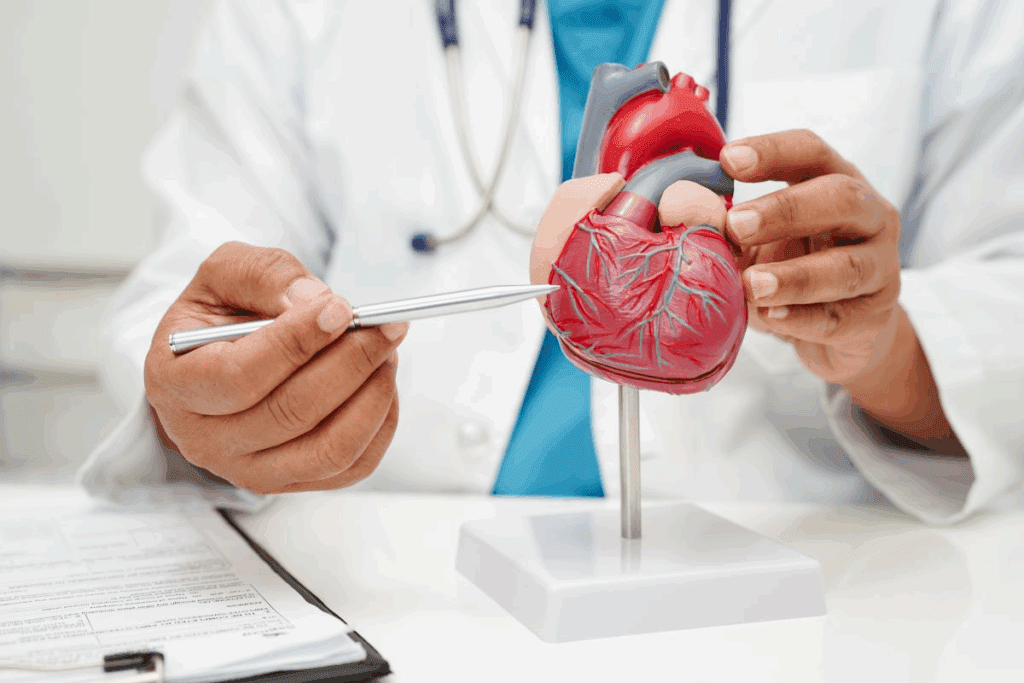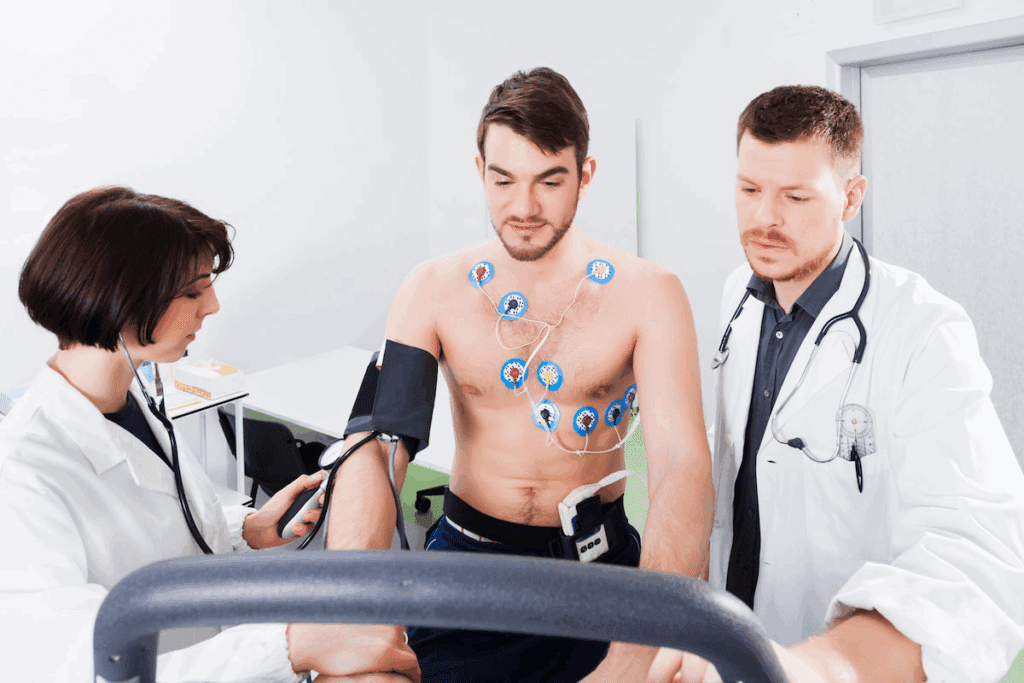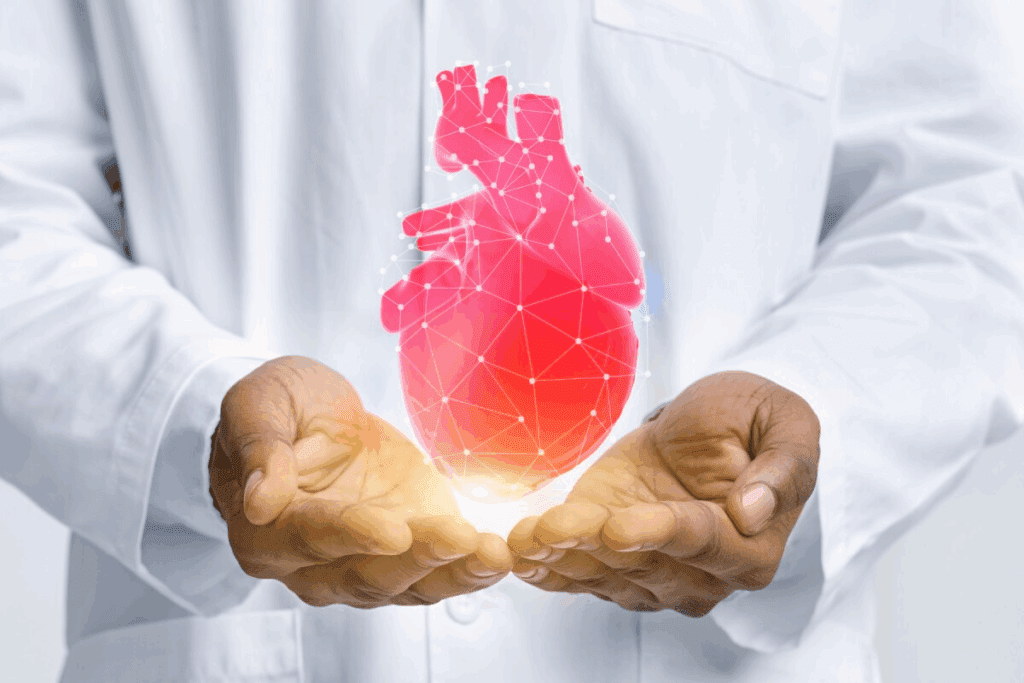Last Updated on November 25, 2025 by Ugurkan Demir

Atrial fibrillation and other heart rhythm disorders can really affect a person’s life. Cardioversion is a medical procedure that offers new hope for those with irregular heartbeats. It’s used to treat arrhythmias, where the heart beats too fast or irregularly.
Knowing the risks and benefits of cardioversion helps patients make better choices. At places like Liv Hospital, we use the latest methods and focus on the patient. This way, we help patients get the best care, from start to finish.

Cardioversion is a complex and fascinating medical procedure. It aims to fix irregular heartbeats in patients with certain arrhythmias.
Cardioversion uses electrical shocks or medicine to fix an abnormal heart rhythm. It turns an irregular heartbeat back to normal. This is done with a controlled electrical shock or special medicines.
Cardioversion helps with many arrhythmias, including:
These conditions can cause symptoms like palpitations, shortness of breath, and fatigue. They can really affect a person’s life quality.
The main goals of cardioversion are to fix the heart rhythm and ease symptoms. It aims to improve a patient’s life quality. By fixing the rhythm, it also lowers the risk of serious problems like stroke and heart failure.
| Arrhythmia Type | Success Rate of Cardioversion | Common Symptoms |
| Atrial Fibrillation | 70-90% | Palpitations, shortness of breath |
| Atrial Flutter | 80-95% | Rapid heartbeat, fatigue |
| Atrial Tachycardia | 60-85% | Rapid heartbeat, dizziness |
| Ventricular Tachycardia | 50-80% | Palpitations, loss of consciousness |
Understanding cardioversion helps patients and doctors make better choices. It’s key in managing heart rhythm disorders.

Cardioversion treats irregular heart rhythms in two main ways. It aims to bring the heart back to a normal rhythm. These methods are electrical cardioversion and pharmacologic cardioversion. Knowing about these is key for both patients and doctors to choose the best treatment.
Electrical cardioversion is like a “shock treatment for the heart.” It uses a controlled electric shock to the chest to fix the rhythm. This is done while the patient is sedated or under anesthesia to reduce pain.
The electric shock is timed with the heart’s cycle for safety and success.
The benefits of electrical cardioversion are:
Pharmacologic cardioversion uses medicines to fix the heart rhythm. It’s often chosen for patients not good for electrical cardioversion or with specific arrhythmias that medicines can help.
Key points about pharmacologic cardioversion are:
Choosing between electrical and pharmacologic cardioversion depends on many factors. These include the arrhythmia type, patient health, and the situation. The main differences are how the rhythm is fixed, how fast it happens, and possible side effects.
| Characteristics | Electrical Cardioversion | Pharmacologic Cardioversion |
| Method | Electric shock | Anti-arrhythmic medications |
| Speed of Effect | Immediate | Variable, depending on medication |
| Potential Risks | Related to anesthesia and electric shock | Medication side effects |
It’s important to know the differences between electrical and pharmacologic cardioversion. This helps decide the best treatment plan. We’ll look at more details and implications in the next sections.
Cardioversion is needed when certain heart rhythms are off. It’s used to fix these issues. This is key for people with specific heart problems.
It’s mainly for treating irregular heartbeats like atrial fibrillation. Symptoms like palpitations or shortness of breath are common reasons. It’s chosen when these symptoms really affect a person’s life or when other treatments don’t work.
Common medical indications for cardioversion include:
Severe palpitations, dizziness, or chest pain might need cardioversion. These symptoms can make it hard to do everyday things. They might show that a person needs this treatment.
Cardioversion can be urgent or planned. Emergency cardioversion is for severe symptoms like unstable heart function. Planned cardioversion is for those with ongoing arrhythmias that haven’t gotten better with other treatments.
| Characteristics | Emergency Cardioversion | Planned Cardioversion |
| Urgency | Immediate, due to severe symptoms | Scheduled in advance |
| Patient Condition | Hemodynamically unstable | Stable, but symptomatic |
| Preparation | Minimal preparation | Anticoagulation therapy and other preparations |
Cardioversion is considered when other treatments don’t work. This includes medicines for heart rhythm. It’s a good option for managing arrhythmias.
Knowing when cardioversion is needed helps both patients and doctors. It’s about making the right choice for heart health.
Getting ready for a cardioversion is key. This includes medical tests and adjusting your medications. It’s important to listen to your doctor and know what to expect.
Your doctor will run several tests before the procedure. These tests check your heart and overall health. You might have:
Medical experts say, “Thorough pre-procedure testing is vital for identifying risks and ensuring a safe procedure.”
Your medications might need to change before the procedure. This could mean:
It’s important to follow your doctor’s advice on medication changes to avoid risks.
Anticoagulation therapy is often used before cardioversion. This means taking medications that thin your blood, like warfarin or NOACs. You’ll need to take these medications for at least three to four weeks before the procedure.
You’ll get advice on fasting and other things to do before the procedure. You might need to:
By following these guidelines, you can help make the procedure go smoothly and successfully.
The cardioversion process has several key steps. These steps ensure a safe and effective way to restore a normal heart rhythm. We will explain what happens before, during, and after the procedure.
Before cardioversion, we conduct several tests to check if you’re a good candidate. These tests include an electrocardiogram (ECG), blood tests, and sometimes a transesophageal echocardiogram (TEE). We also review your medications to reduce risks during the procedure.
Pre-procedure preparation is key for a successful cardioversion. You’ll get instructions on fasting and arranging a ride home. It’s important to follow these steps carefully.
During electrical cardioversion, you’ll receive sedation to relax. We monitor your heart rhythm and vital signs closely. Electrode patches are placed on your chest and connected to a cardioversion device.
The electric shock is timed with your ECG’s R-wave to reduce risks. We watch how you respond and might adjust the shock’s energy level if needed.
Pharmacologic cardioversion uses medications to restore a normal heart rhythm. We choose the right medication based on your condition and medical history. The medication is given intravenously, and we monitor your heart rhythm and response.
The goal is to convert your arrhythmia to a normal rhythm without electric shock. We watch for side effects and adjust the treatment as necessary.
During the procedure, whether electrical or pharmacologic, we monitor your heart rhythm, blood pressure, and oxygen levels. This lets us quickly respond to any changes or complications.
Our close monitoring ensures your safety and the procedure’s success. We adjust our approach as needed to achieve the best outcome.
Recovering from cardioversion involves several stages. These include immediate care after the procedure and getting back to normal activities. Knowing these stages helps patients recover smoothly.
Right after the procedure, patients go to a recovery area. Medical staff watch over them closely. This stage is key for catching any early signs of trouble.
Monitoring and Care: Patients are checked for heart rhythm and overall health. Staff look for any complications, like arrhythmias or reactions to anesthesia.
Most patients can go home the same day, if there are no issues. Before leaving, they get care instructions and schedule follow-up visits.
Discharge Criteria: Patients are sent home when they’re stable and fully awake. They must also show no immediate complications.
| Discharge Criteria | Description |
| Stable Condition | Patient’s vital signs are within normal limits. |
| Return to Pre-Procedure Consciousness | Patient is fully awake and alert. |
| No Immediate Complications | No signs of arrhythmias or other complications. |
After cardioversion, patients need to follow activity limits. This means avoiding hard work and heavy lifting for a while.
“It’s vital for patients to stick to their activity limits. This helps avoid complications after cardioversion.”
Starting exercise after cardioversion should be slow and guided by a doctor. The aim is to get back to normal without pushing too hard.
Guidelines for Resuming Exercise: Begin with light activities and slowly increase intensity. It’s important to listen to how your body feels and adjust as needed.
By following these guidelines and their healthcare team’s advice, patients can recover safely and effectively after cardioversion.
It’s important to know the risks and complications of cardioversion before you decide to have it. While it’s usually safe, there are some possible risks.
Most people who have cardioversion don’t have big problems. But, some might face minor issues like:
Even though they’re rare, serious problems can happen. These might include:
For those getting medication to help their heart, there are extra risks. These can be:
Talking to your doctor about your health and any worries you have is key to lowering risks.
It’s important to know the long-term effects of cardioversion before you decide on it. This treatment can fix a heart rhythm problem. But, it’s key to think about its long-term success and possible side effects.
Cardioversion is usually safe, but it can have some long-term effects. Some people might see:
These effects are usually short-lived and go away by themselves. But, it’s important to check in with your doctor to make sure everything is okay.
The emotional side of cardioversion is also important. Patients might feel anxious or stressed about the procedure and their heart health. Talking to your doctor about these feelings is a big help.
Another thing to think about is if arrhythmias might come back. How likely this is depends on your heart condition and how well you take care of yourself after the procedure. Staying on top of your medications and doctor visits can help.
Several things can affect how well cardioversion works in the long run. These include:
By understanding and dealing with these factors, you can increase your chances of a good outcome.
In summary, cardioversion is a good option for some heart rhythm problems. But, knowing its long-term effects and success rates is key to making the right choice. Thinking about the physical and emotional impacts, and what affects long-term success, helps patients make the best decisions for their treatment.
Understanding the safety of cardioversion is key. It’s seen as safe when done right, but it has risks and complications.
Cardioversion is mostly safe for most people. Electrical cardioversion is safe with the right precautions. But, some factors can raise the risk of problems.
Not everyone is a good candidate for cardioversion. Those with heart issues like digitalis toxicity or severe heart failure are at higher risk. Choosing the right patients and checking them before the procedure is important.
Some factors can make cardioversion riskier. These include a history of arrhythmias, pacemakers or ICDs, and certain meds. Knowing these helps manage what to expect.
Doctors take many steps to keep patients safe during cardioversion. They do a detailed check before, watch closely during, and care for patients after. Anticoagulation therapy helps prevent blood clots. Having skilled staff and the right tools is also key.
With the right steps, cardioversion can be a safe and helpful treatment for heart rhythm problems.
Understanding cardioversion helps patients make smart choices. It’s a key treatment for heart rhythm problems, aiming to fix the heart’s rhythm.
It’s important to think about the cardioversion risks and benefits when deciding. While it’s usually safe, there can be side effects or serious issues. Your doctor will guide you, helping you choose the best path.
To make a good choice, look at your health, the heart issue, and what cardioversion can do. Talk to your doctor about your worries. This way, you’ll be ready to decide on this treatment.
For many, cardioversion can change their life for the better. By carefully looking at the treatment, you can pick what’s best for your health and well-being.
Cardioversion is a medical procedure. It helps people with abnormal heart rhythms, or arrhythmias, get back to a normal rhythm.
No, it’s not surgical. It’s a non-invasive treatment. It uses electrical shocks or medications to fix the heart rhythm.
Minor risks include skin irritation or redness. Serious risks like stroke, heart attack, or cardiac arrest are rare but possible.
Recovery is usually quick. Most people can get back to normal in a few days. Always follow your doctor’s advice on activity and exercise.
Yes, it can be done in emergencies. This is if the arrhythmia is life-threatening or causing severe symptoms.
Electrical cardioversion uses shocks to fix the rhythm. Pharmacologic cardioversion uses medications for the same purpose.
It’s usually effective in fixing the rhythm. But success depends on the arrhythmia cause and any underlying health issues.
Long-term side effects are rare. But some might experience psychological impacts or arrhythmia recurrence.
Always follow your doctor’s exercise advice after cardioversion. Avoid strenuous activities for a few days and then gradually return to normal exercise.
Some people, like those with certain medical conditions or on specific medications, should avoid it. Always talk to your healthcare provider about your situation.
Doctors ensure safety by carefully choosing patients, monitoring during the procedure, and adjusting treatment plans as needed.
Success rates vary based on the individual and the arrhythmia type. It’s often effective for certain arrhythmias.
White, H. J. (2023). Anatomy, Thorax, Superior Vena Cava. In StatPearls. National Center for Biotechnology Information. https://www.ncbi.nlm.nih.gov/books/NBK545255/
Subscribe to our e-newsletter to stay informed about the latest innovations in the world of health and exclusive offers!